Notes: Ballinderry station was situated on the 20 mile Lisburn – Antrim branch which was opened by the Dublin & Antrim Junction Railway (DAJR) on 13 November 1871.It connected the Belfast – Portadown line of the Ulster Railway (UR) at Knockmore Junction (Lisburn) to the Belfast – Coleraine line of the Belfast & Northern Counties Railway (B&NCR) at Antrim. At the time of opening there were 5 stations on the line including Ballinderry.
The station at Ballinderry was opened with the line on 13 November 1871. It was located ¼ of a mile to the north of its namesake 5¼ miles to the north of Knockmore Junction. The station was on the west side of Glenavy Road which passes over the line on a bridge.
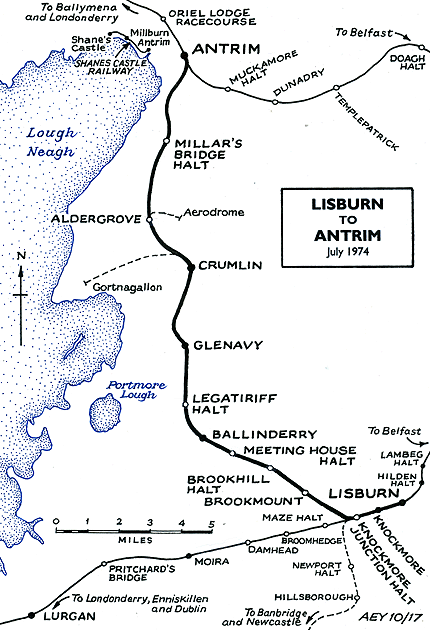 The line was a single track railway built to the Irish standard gauge (5ft 3inch). A passing loop was provided at Ballinderry so the station had two platforms. The platforms were linked by barrow crossings at each end of the station. The line was a single track railway built to the Irish standard gauge (5ft 3inch). A passing loop was provided at Ballinderry so the station had two platforms. The platforms were linked by barrow crossings at each end of the station.
The main facilities were located on the northbound (Antrim direction) platform. At the time of opening this was designated as the down line platform. They were accessed from Station Road by a driveway. A barrow crossing gave access to the southbound platform which was also connected to Glenavy Road by a path.
Goods facilities were located on the south side of the line behind the northbound platform. They included a siding and a goods shed.
Passenger services were operated by the UR mostly running between Belfast Great Victoria Street and Antrim.
On 1 April 1876 the UR was absorbed into the Great Northern Railway Ireland (GNRI) and from that date they operated the train services. In 1879 the DAJR was taken over by the GNRI.
In 1882 the GNRI improved the facilities at Ballinderry. A single storey brick built building was provided on the Antrim direction platform. It was built to a design that had been developed for the GNRI by architect William H Mills. A timber waiting shelter with a glass front was provided on the southbound platform (Knockmore direction).
A signal box controlled the main line and the connection to the goods yard. It had a brick base with timber upper cabin and it was located on the east side of the line just to the north of the platform.
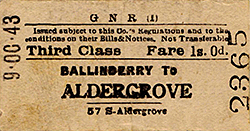 A house for the Station Master was provided on the south side of the line on the driveway that connected to Station Road. A house for the Station Master was provided on the south side of the line on the driveway that connected to Station Road.
The December 1896 timetable showed 4 trains in each direction Monday to Saturday and a train each way on Sundays. At this time the up direction was still considered to be to Knockmore Junction and the down to Antrim.
The 1904 Railway Clearing House Handbook of Stations listed Ballinderry as being able to handle passengers, parcels, general goods and livestock. The yard crane was capable of lifting 1-ton.
The July 1922 timetable showed the same level of service as there had been in 1895 as seen in the table below. By this time the GNRI had reversed the direction protocol for the line. Up was to Antrim and down to Knockmore Junction.
| Up Trains - July 1922 |
Destination |
Down Trains - July 1922 |
Destination |
| 9.47am |
Antrim |
8.15am |
Belfast Great Victoria Street |
| 12.01pm |
Antrim |
10.51am (Monday and Tuesday Only) |
Belfast Great Victoria Street |
| 2.43pm (Saturdays Only) |
Antrim |
11.02am (Monday and Tuesday Excepted) |
Belfast Great Victoria Street |
| 3.56pm (Saturdays excepted) |
Antrim |
2.12pm |
Belfast Great Victoria Street |
| 6.58pm |
Antrim |
6.19pm |
Belfast Great Victoria Street |
| Sundays |
|
Sundays |
|
| 10.15am |
Antrim |
8.13pm |
Belfast Great Victoria Street |
In 1922 following the Irish War of Independence (1919 – 1922) 1922 the island of Ireland was divided into two separate states, The Irish Free State (after 1948 Republic of Ireland) and Northern Ireland. The GNRI network was located in both countries which caused it some difficulties. The Antrim branch was entirely within Northern Ireland so little changed with regards to its train services.
By the 1920s a grounded coach body had been added to the northbound platform to provide extra storage.
During the 1920s and 1930s the GNRI suffered competition from road transport. Local bus services hit passenger receipts and private hauliers using lorries had an impact on freight.
The Second World War (1939 – 1945) was a busy period for the GNRI and traffic levels increased significantly. In 1942 a branch line was opened between Crumlin and Gortnagallon where the United States Army Air Force (USAAF) opened an air base which was known as Langford Lodge Base Air Depot Number 3. From May 1942 passenger services were operated to and from Gortnagallon for workers and military personnel. The passenger services to Gortnagallon had ended by October 1945 and the branch was lifted by 11 April 1948 (when the Siding Junction was removed).
After the war there was a resurgence in the competition from road transport and that put the GNRI in a difficult financial situation. At first it was aided by both governments but that was set to change with the creation of the Ulster Transport Authority (UTA).
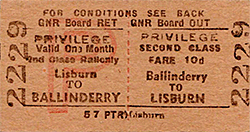 The UTA was created by the Northern Ireland government in 1948 to run nationalised transport undertakings. All of the railways in Northern Ireland, with the exception of the GNRI, came under its jurisdiction in 1949. The UTA, along with the Northern Ireland Government, was notoriously anti-rail (in 1950 it closed the entire Belfast & County Down Railway system except for the Belfast – Bangor line). In 1953 the GNRI was jointly nationalised as the Great Northern Railway Board (GNRB). During this period the UTA was busy closing lines throughout Northern Ireland but the joint nature of the GNRB arrangement staved off closures on the former GNRI system until 1958. Frustrated at not being able to close the lines of the former GNRI the Northern Ireland government dissolved the GNRB in May 1958. They divided the assets between the two states depending upon which side of the border they were located. Ballinderry station and the former GNRI lines in Northern Ireland became part of the UTA. The UTA was created by the Northern Ireland government in 1948 to run nationalised transport undertakings. All of the railways in Northern Ireland, with the exception of the GNRI, came under its jurisdiction in 1949. The UTA, along with the Northern Ireland Government, was notoriously anti-rail (in 1950 it closed the entire Belfast & County Down Railway system except for the Belfast – Bangor line). In 1953 the GNRI was jointly nationalised as the Great Northern Railway Board (GNRB). During this period the UTA was busy closing lines throughout Northern Ireland but the joint nature of the GNRB arrangement staved off closures on the former GNRI system until 1958. Frustrated at not being able to close the lines of the former GNRI the Northern Ireland government dissolved the GNRB in May 1958. They divided the assets between the two states depending upon which side of the border they were located. Ballinderry station and the former GNRI lines in Northern Ireland became part of the UTA.
The 1956 Handbook of Stations listed Ballinderry as being able to handle passengers, general goods, parcels, livestock and horse boxes. At that time the yard crane was capable of lifting 1 ton.
The southbound line (at this time still the down) was lifted in 1959.
On 12 September 1960 the passenger service between Belfast Great Victoria Street and Antrim was withdrawn and all of the stations on the Antrim branch, including Ballinderry, were closed completely.
The line had to remain open to serve goods services that ran to and from the Republic of Ireland. The goods sidings were lifted and the southbound platform waiting room was demolished.
After 15 February 1965 when the Portadown – Londonderry line was closed additional freight traffic started to use the line as it formed the only surviving route between Londonderry and the Republic of Ireland.
In 1968 the UTA was abolished and what was left of the Northern Ireland railway network became part of Northern Ireland Railways (NIR). NIR was a more pro-rail organisation and it set about making improvements to the network in the Belfast area. One of the most significant improvements saw the creation of a Belfast Central station which opened on 12 April 1976. The new station was designed to replace three termini that were located in different parts of the city and bring the train services together. At the time of opening it was able to replace two of the stations (Belfast Great Victoria Street and Belfast Queens Quay). It was also able to handle Londonderry services through a reopening of the Antrim branch.
To facilitate the running of Londonderry services into Belfast Central the Antrim branch was refurbished. Under NIR the line reverted to up being the Knockmore direction and down the Antrim direction.
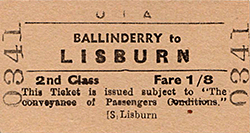 At Ballinderry the passing loop was put back. The station building was altered so that part of it became an open fronted waiting shelter and part was adapted to house signalling equipment (controlled from Antrim) for the passing loop. At Ballinderry the passing loop was put back. The station building was altered so that part of it became an open fronted waiting shelter and part was adapted to house signalling equipment (controlled from Antrim) for the passing loop.
A local passenger service was introduced between Lisburn and Antrim on 26 January 1974. It called at Ballinderry and the other stations on the line. From 23 January 1978 Londonderry services started to run along the Antrim branch but most of them didn’t call at Ballinderry.
The June 1980 timetable showed 7 Belfast Central and 6 Antrim trains Monday-to-Friday. On Saturdays there were 7 trains to Belfast and 5 trains to Antrim. No trains called at Ballinderry on Sundays.
The aspiration of linking all of the Belfast termini had not been achieved in 1976 as Belfast York Road station had remained open to serve the Larne line. After 1976 this line was physically isolated from the rest of the system and NIR continued to pursue its objective of connecting it to Belfast Central. In the early 1990s work began on the Belfast Cross Harbour railway which opened on 28 November 1994. Larne line trains could now reach Belfast Central. The former NCC route between Belfast and Londonderry was shorter than the route via the Antrim branch and this led to NIR reopening the Antrim – Bleach Green Junction line to passenger services on 15 October 2001. From that date Belfast – Londonderry services ceased to run via Ballinderry.
To serve the former GNRI Antrim branch a limited Belfast – Antrim service was operated. The July 2002 timetable showed 3 trains in each direction Monday-to-Friday. On Saturdays there were 4 services to Belfast, 2 services to Portrush and 1 service to Antrim. There was also a Sunday service of 1 train in each direction. The service was withdrawn completely on 30 June 2003 and Ballinderry station was closed once again.
The southbound line (by this time the up once again) was removed in the early months of 2017.
In 2017 the station was extant and line was used by occasional passenger diversions, engineering trains and enthusiasts’ specials.
Tickets from Michael Stewart and route map by Alan Young
Sources:
- Along UTA Lines, Ulsters Rail Network in the 1960s - Ian McLarnon Sinclair - Colourpoint 2009
- Dark Days and Brighter Days for Northern Ireland Railways - Edwin McMillan - Colourpoint 2016.
- Johnson's Atlas & Gazetteer of the Railways of Ireland - Stephen Johnson - Midland Publishing 1997
- One Hundred and Fifty Years of Irish Railways - Fergus Mulligan - Appletree Press 1983.
- Railways in Ireland, Part 2 - Martin Bairstow 2007
- The Great Northern Railway, an Irish Railway Pictorial - Tom Ferris - Midland Publishing 2003
To see the GNRI Antrim branch click
on the station name: Knockmore, Knockmore Junction Halt, Brookmount, Brookhill Halt, Meeting House Halt, Legatiriff Halt, Glenavy, Crumlin, Aldergrove and Millar's Bridge Halt |

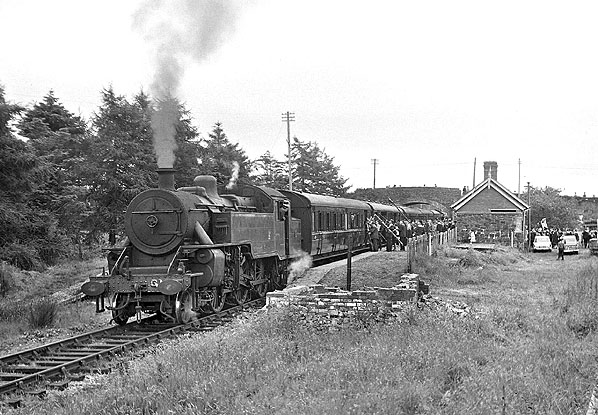
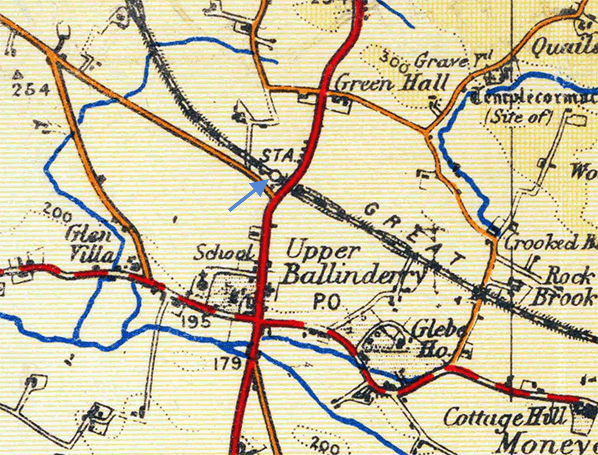

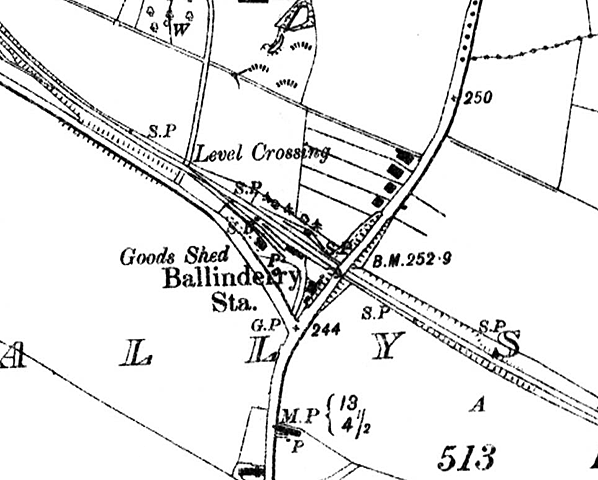
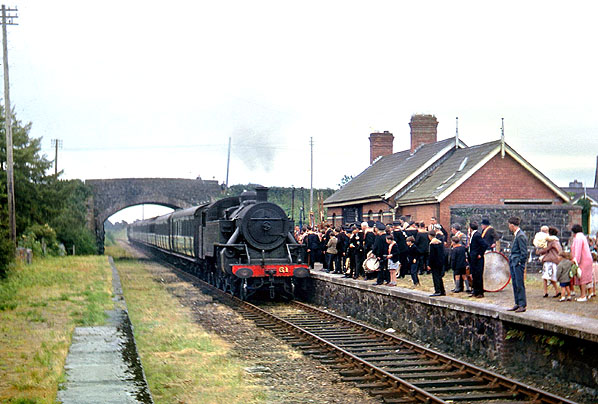
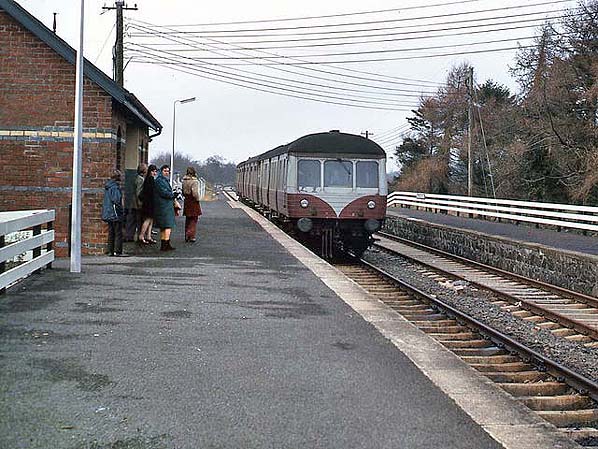 An Antrim to Lisburn service arrives at Ballinderry in April 1974.
An Antrim to Lisburn service arrives at Ballinderry in April 1974.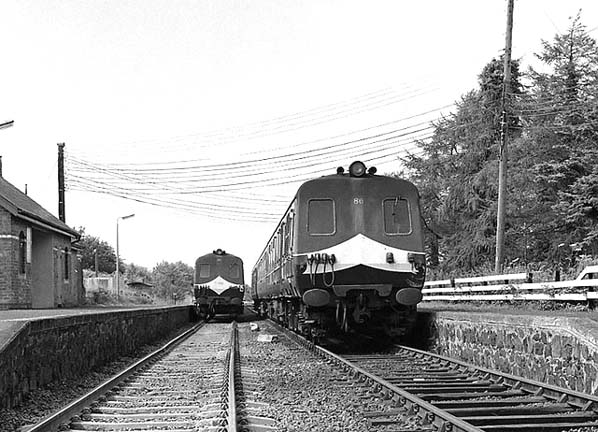
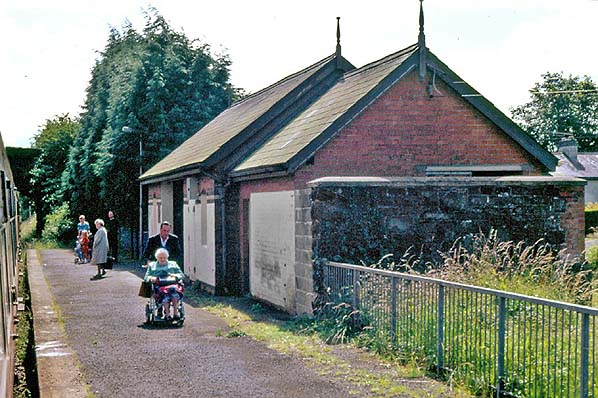 The station building at Ballinderry seen from a northbound train on 14 June 1993.
The station building at Ballinderry seen from a northbound train on 14 June 1993.


 The line was a single track railway built to the Irish standard gauge (5ft 3inch). A passing loop was provided at Ballinderry so the station had two platforms. The platforms were linked by barrow crossings at each end of the station.
The line was a single track railway built to the Irish standard gauge (5ft 3inch). A passing loop was provided at Ballinderry so the station had two platforms. The platforms were linked by barrow crossings at each end of the station.  A house for the Station Master was provided on the south side of the line on the driveway that connected to Station Road.
A house for the Station Master was provided on the south side of the line on the driveway that connected to Station Road.  The UTA was created by the Northern Ireland government in 1948 to run nationalised transport undertakings. All of the railways in Northern Ireland, with the exception of the GNRI, came under its jurisdiction in 1949. The UTA, along with the Northern Ireland Government, was notoriously anti-rail (in 1950 it closed the entire Belfast & County Down Railway system except for the Belfast – Bangor line). In 1953 the GNRI was jointly nationalised as the Great Northern Railway Board (GNRB). During this period the UTA was busy closing lines throughout Northern Ireland but the joint nature of the GNRB arrangement staved off closures on the former GNRI system until 1958. Frustrated at not being able to close the lines of the former GNRI the Northern Ireland government dissolved the GNRB in May 1958. They divided the assets between the two states depending upon which side of the border they were located. Ballinderry station and the former GNRI lines in Northern Ireland became part of the UTA.
The UTA was created by the Northern Ireland government in 1948 to run nationalised transport undertakings. All of the railways in Northern Ireland, with the exception of the GNRI, came under its jurisdiction in 1949. The UTA, along with the Northern Ireland Government, was notoriously anti-rail (in 1950 it closed the entire Belfast & County Down Railway system except for the Belfast – Bangor line). In 1953 the GNRI was jointly nationalised as the Great Northern Railway Board (GNRB). During this period the UTA was busy closing lines throughout Northern Ireland but the joint nature of the GNRB arrangement staved off closures on the former GNRI system until 1958. Frustrated at not being able to close the lines of the former GNRI the Northern Ireland government dissolved the GNRB in May 1958. They divided the assets between the two states depending upon which side of the border they were located. Ballinderry station and the former GNRI lines in Northern Ireland became part of the UTA. At Ballinderry the passing loop was put back. The station building was altered so that part of it became an open fronted waiting shelter and part was adapted to house signalling equipment (controlled from Antrim) for the passing loop.
At Ballinderry the passing loop was put back. The station building was altered so that part of it became an open fronted waiting shelter and part was adapted to house signalling equipment (controlled from Antrim) for the passing loop. 
 Home Page
Home Page